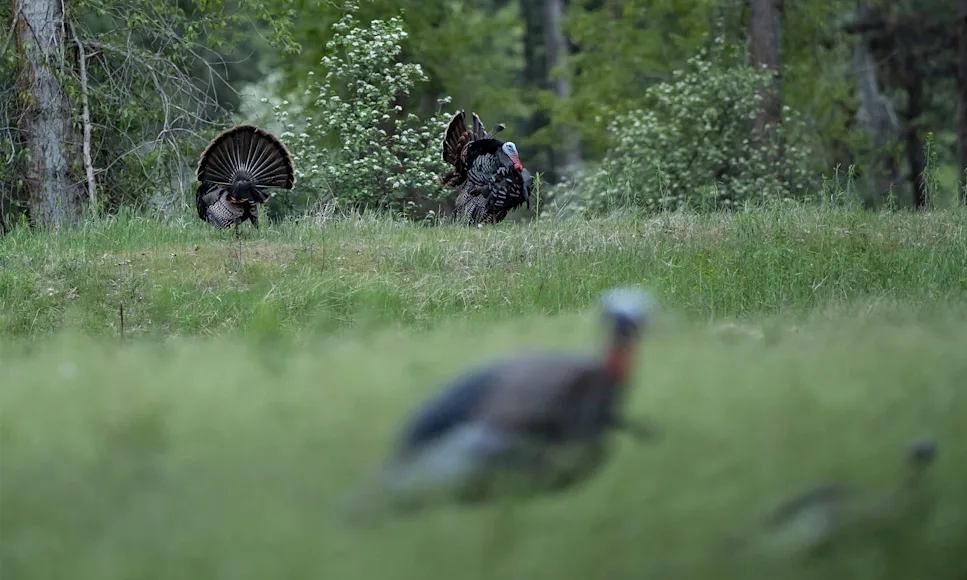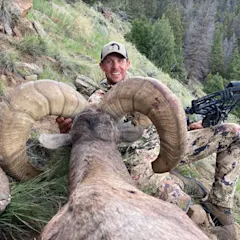The late season can be a challenging time for hunters in the turkey woods. Though it varies by region, turkey biologists agree that a significant portion of wild turkey breeding has already occurred by the second half of spring seasons. Pecking orders are established, younger toms have had their butts whipped a time or two, and gaggles of jakes have certainly whooped some boss toms off their hens. Plus, almost no matter where you hunt, chances are high that birds have seen significant amount of hunting pressure—which means they've seen their share of fake turkeys.
Put it all together, and it's no wonder late-season toms have a reputation for being decoy-shy. Enough so that a lot of hunter put leave their decoys at home now. That's one option, but that fact is, toms will still come to decoys now if you set them up right. They might even give your jake fake a good whooping in the bargain. Here are four sure-fire late-season decoy tactics to help bring a tom into shotgun or bow range.
Related: Best Turkey Shotguns of 2025
4 Late-Season Decoy Setup Tips

1. Downsize the Deke
A full-strut tom decoy can be pure poison at times, partly because of the decoy's size and visibility. A puffed-up body with a fan spread wide stands out in the woods. But during the season, I put the big strutter away and use a smaller-sized jake decoy—specifically, the Avian-X LCD 1/2-Strut Jake. I love that this realistic decoy is inflatable; you can pack it anywhere, and it blows up in seconds. But also, this fake 15 percent smaller than the size of an actual turkey and features a sub-dominant posture, that's less likely to intimidate a battle-weary tom.

Late in the season, or anytime toms aren't committing, I go with the LCD 1/2-Strut Jake, and when I set the decoy, my aim to make the already diminutive imposter look even smaller. I do this by pushing the stake into the ground until the fake legs on the decoy are flush with the ground. It works like a charm. I keep a turkey journal, and 13 of the last 16 toms that have seen this decoy have not only committed but have also flogged my jake decoy.
2. Play the Jealousy Card

Another good tip is to use that same jake decoy, set up as described above, and pair it with an Avian-X LCD Laydown Hen or the Mating Hen from DSD. I have both, and the realism of both produces results. Early in the season, I put enough space between the jake and laydown for a tom to maneuver between the two decoys. Dominant gobblers and even boisterous two-year-olds love to get between the jake and his lady, blow up into strut, and face imposter. But during the late season, I put the 1/2-Strut Jake directly over the ready-to-breed hen decoy. To a tom, this looks like a puny bird about to mount a hen, and it is usually all it takes to push a tom over the edge and get him to commit.
Related: Best Turkey Decoys of 2025
3. Try a Lone Hen
Turkeys have personalities, and if you hunting a shy bird—a tom that slinks around, avoiding trouble—or if you're hunting an area where you know the birds have seen tons of pressure, it can pay to ditch the male decoy altogether. When I go with a single-hen decoy set, I prefer a feeding, lookout, or posturing hen. A single-feeding hen, for example, is non-threatening and conveys a sense of safely contentment. A gobbler can sit back, evaluate the situation, see no boy birds around, and make his move.
Though it's challenging to predict which direction a tom will come from, try to use your knowledge of the property, as well as digital mapping apps, to make a prediction. Then position the hen on a trail so that it is facing away from the boy bird's predicted approach. With the hen facing away, a tom will think the hen is moving away and will have more pep in his step to close the distance quickly. I've seen a bunch of late-season toms run to this setup.
4. Loose the Decoy in Deep Woods

I was getting my butt handed to me in years back in Missouri. The public parcel I was hunting held plenty of birds, but the parking areas were covered in tire tracks, and trails in and out of the woods were dotted with boot prints. Birds would gobble hard on the roost, fly down, and shut up. You wouldn't see a bird in a clearing; even a logging road sighting was rare. The pressure had put the birds in the deep woods.
It took me several days to figure things out, but what I learned on that hunt has been invaluable since when dealing with pressured late-season toms. When gobblers stick to the woods, you're best bet is to ditch the decoys altogether. When toms respond to your calling and come looking for the "hen," stumbling onto a "rival" tom or jake decoy is usually an unwelcome surprise. And if they see a hen decoy, they're apt to strut out of range for 20 minutes before losing interest.
Instead, make that tom come find you. Male birds know they must look hard to find the hen in the woods, and they'll pinpoint the sound. A good trick is to call 20 or 30 yards away from where you plan to sit, then shut up. The approaching tom will fix his eyes where he last heard hen talk, lessening the chance of him spotting you. It doesn't take a timber tom long to realize he's been fooled, so take the first ethical shot he gives you.


